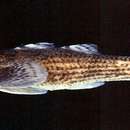Diagnostic Description
provided by Fishbase
Characterized by having enlarged, thickened and wide pectoral fins; widely spaced broad fleshy pelvic fin; head and snout flattened, small dorsolaterally oriented eyes; small ventrally placed mouth; accessory lateral line canals dorsal and ventral to the lateral line on the body, including caudal fin base; caudal fin large (Ref. 92840).
Migration
provided by Fishbase
Amphidromous. Refers to fishes that regularly migrate between freshwater and the sea (in both directions), but not for the purpose of breeding, as in anadromous and catadromous species. Sub-division of diadromous. Migrations should be cyclical and predictable and cover more than 100 km.Characteristic elements in amphidromy are: reproduction in fresh water, passage to sea by newly hatched larvae, a period of feeding and growing at sea usually a few months long, return to fresh water of well-grown juveniles, a further period of feeding and growing in fresh water, followed by reproduction there (Ref. 82692).
- Recorder
- Crispina B. Binohlan
Morphology
provided by Fishbase
Dorsal spines (total): 8; Dorsal soft rays (total): 8 - 9; Analspines: 1; Analsoft rays: 8 - 9
Biology
provided by Fishbase
Inhabits relatively steep gradient coastal streams in hilly or mountainous terrain. Feeds on algae and diatoms; effectively clings on rocks and boulders with its broadened pelvic and pectoral fins and flattened head and snout (Ref. 92840).
- Recorder
- Crispina B. Binohlan
Importance
provided by Fishbase
fisheries: minor commercial; price category: unknown; price reliability:
- Recorder
- Crispina B. Binohlan
分布
provided by The Fish Database of Taiwan
分布於亞洲與大洋洲,包括印尼、菲律賓、新幾內亞、索羅門群島、台灣與一些日本的島嶼。台灣分布於未受嚴重污染的溪流河川中,尤以東部溪流為甚。
利用
provided by The Fish Database of Taiwan
小型魚類,可食用,或可做為觀賞用。
描述
provided by The Fish Database of Taiwan
體延長,頭部縱扁,身體中央以後側扁,腹面扁平,尾柄長;口甚小,開於吻端腹側,略呈三角形,上唇肥厚,下唇隱於腹面;眼睛位於頭頂。體被櫛鱗;側線完全。背鰭分離;臀鰭與背鰭相對;第二胸鰭大,扇形,蓋住腹鰭之上,二者均往兩側平伸而共同形成一吸著面;尾鰭內凹。身體背側略呈暗褐色或黃褐色,腹面略白;體側及背有3-4個暗黑色寬橫斑,腹鰭趾墊部份呈紅褐色。各鰭淡白而有暗紋分布。
棲地
provided by The Fish Database of Taiwan
棲息於相當陡峭的海岸溪流,或在多丘陵,或多山地帶的溪流中。仔稚魚是在沿岸地區棲息,再溯河成長,是典型的溯河洄游性魚,在台灣的夏季裡,會和其它鰕虎科魚類的幼苗一起自河口上溯,尤其在東部的溪流較多見;成魚通常在河川的潭頭或瀨區中活動,警覺性高。主要以刮食石頭上之藻類為生。
Loach goby
provided by wikipedia EN
The loach goby, Rhyacichthys aspro, is a goby belonging to the family Rhyacichthyidae. It is not fished commercially.
Taxonomy
The loach goby is one of the two species classified under the genus Rhyacichthys in the family Rhyacichthyidae.
Thacker and Hardman's study of the molecular phylogeny of gobies indicates the loach goby is the most primitive member of the Gobioidei.[3]
Description
The loach goby is 25–32 centimetres (9.8–12.6 in) long. It has eight dorsal spines, eight or 9 soft dorsal rays, one anal spine, and eight or 9 anal rays. The head is flattened vertically, with a snout and small eyes. The mouth is on the underside and has a fleshy upper lip. The body is laterally compressed toward the slightly forked tail; it has a well-developed lateral line system. The pelvic fins are separate, with enlarged musculature. In colour, it is light brown, with darker, longitudinal stripes on its flanks. Also, dark stripes occur on the dorsal, caudal, and pectoral fins.[2]
Distribution and habitat
The loach goby lives in tropical waters between 24°N and 13°S, ranging from China and south Japan, through the Philippines and Indonesia, to New Guinea and the Solomons. It inhabits fast-flowing streams in mountainous terrain.[1][2]
Habits
The loach goby normally clings to rocks in fast-flowing streams, using the rocks as hiding places when threatened. It makes swift darting movements. It eats the algae growing on the rock surfaces.[2]
References

- license
- cc-by-sa-3.0
- copyright
- Wikipedia authors and editors
Loach goby: Brief Summary
provided by wikipedia EN
The loach goby, Rhyacichthys aspro, is a goby belonging to the family Rhyacichthyidae. It is not fished commercially.
- license
- cc-by-sa-3.0
- copyright
- Wikipedia authors and editors

